fuel cap MERCEDES-BENZ E-CLASS ESTATE 2015 User Guide
[x] Cancel search | Manufacturer: MERCEDES-BENZ, Model Year: 2015, Model line: E-CLASS ESTATE, Model: MERCEDES-BENZ E-CLASS ESTATE 2015Pages: 497, PDF Size: 16.23 MB
Page 408 of 497
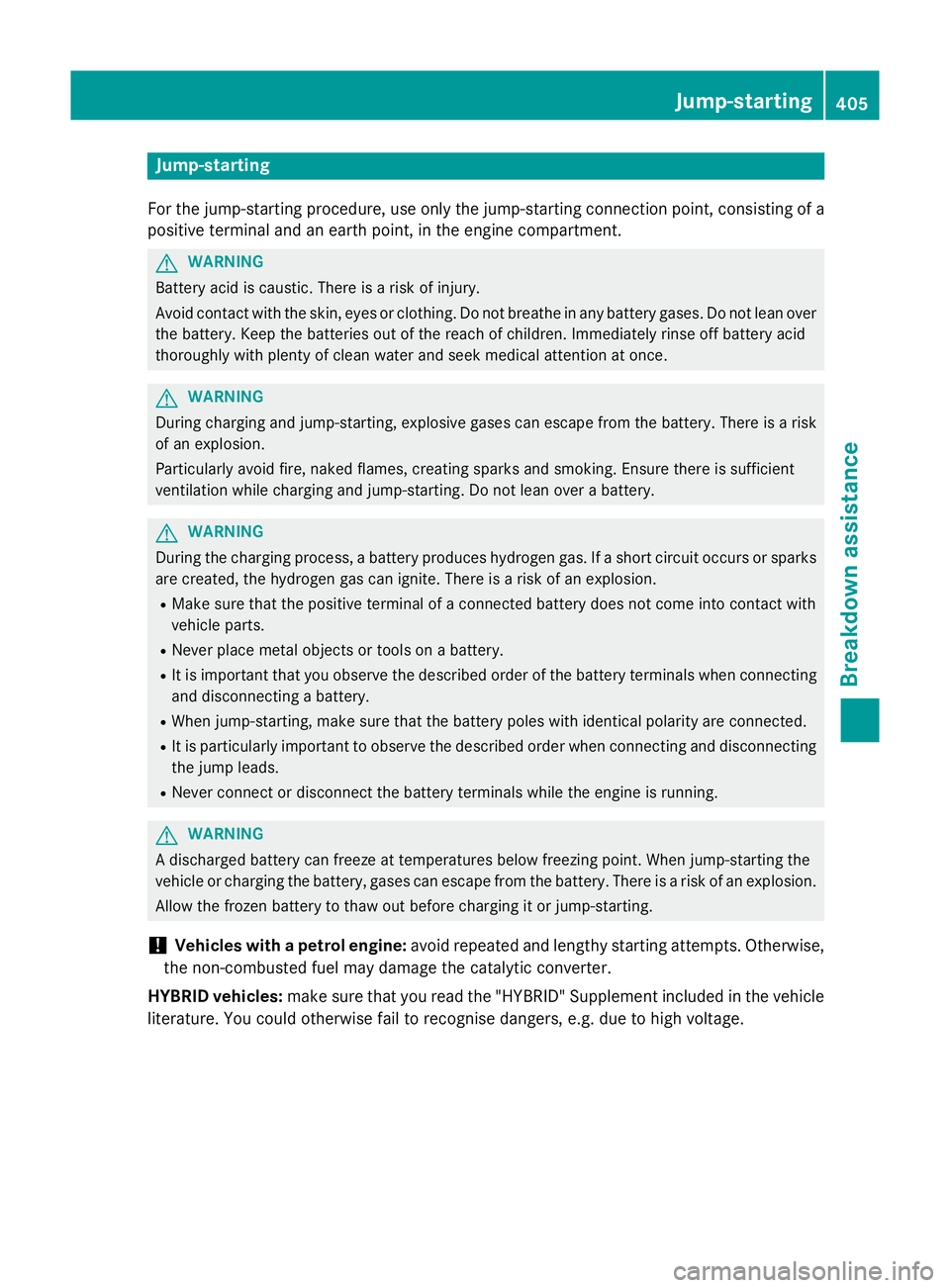
Jump-starting
For the jump-starting procedure, use only the jump-starting connection point, consisting of a positive terminal and an earth point, in the engine compartment. G
WARNING
Battery acid is caustic. There is arisk of injury.
Avoid contact with the skin, eyes or clothing. Do not breathe in any battery gases. Do not lean over the battery. Keep the batteries out of the reach of children. Immediately rinse off battery acid
thoroughly with plenty of clean water and seek medical attention at once. G
WARNING
During charging and jump-starting, explosive gases can escape from the battery. There is arisk
of an explosion.
Particularly avoid fire, naked flames, creating sparks and smoking. Ensure there is sufficient
ventilation while charging and jump-starting. Do not lean over abattery. G
WARNING
During the charging process, abattery produces hydrogen gas. If ashort circuit occurs or sparks
are created, the hydrogen gas can ignite. There is arisk of an explosion.
R Make sure that the positive terminal of aconnected battery does not come into contact with
vehicle parts.
R Never place metal objects or tools on abattery.
R It is important that you observe the described order of the battery terminals when connecting
and disconnecting abattery.
R When jump-starting, make sure that the battery poles with identical polarity are connected.
R It is particularly important to observe the described order when connecting and disconnecting
the jump leads.
R Never connect or disconnectt he battery terminals while the engine is running.G
WARNING
Ad ischarged battery can freeze at temperatures below freezing point. When jump-starting the
vehicle or charging the battery, gases can escape from the battery. There is arisk of an explosion.
Allow the frozen battery to thaw out before charging it or jump-starting.
! Vehicles with
apetrol engine: avoid repeated and lengthy startinga ttempts. Otherwise,
the non-combusted fuel may damage the catalytic converter.
HYBRID vehicles: make sure that you read the "HYBRID" Supplement included in the vehicle
literature. You could otherwise fail to recognise dangers, e.g. due to high voltage. Jump-starting
405Breakdown assistance Z
Page 423 of 497
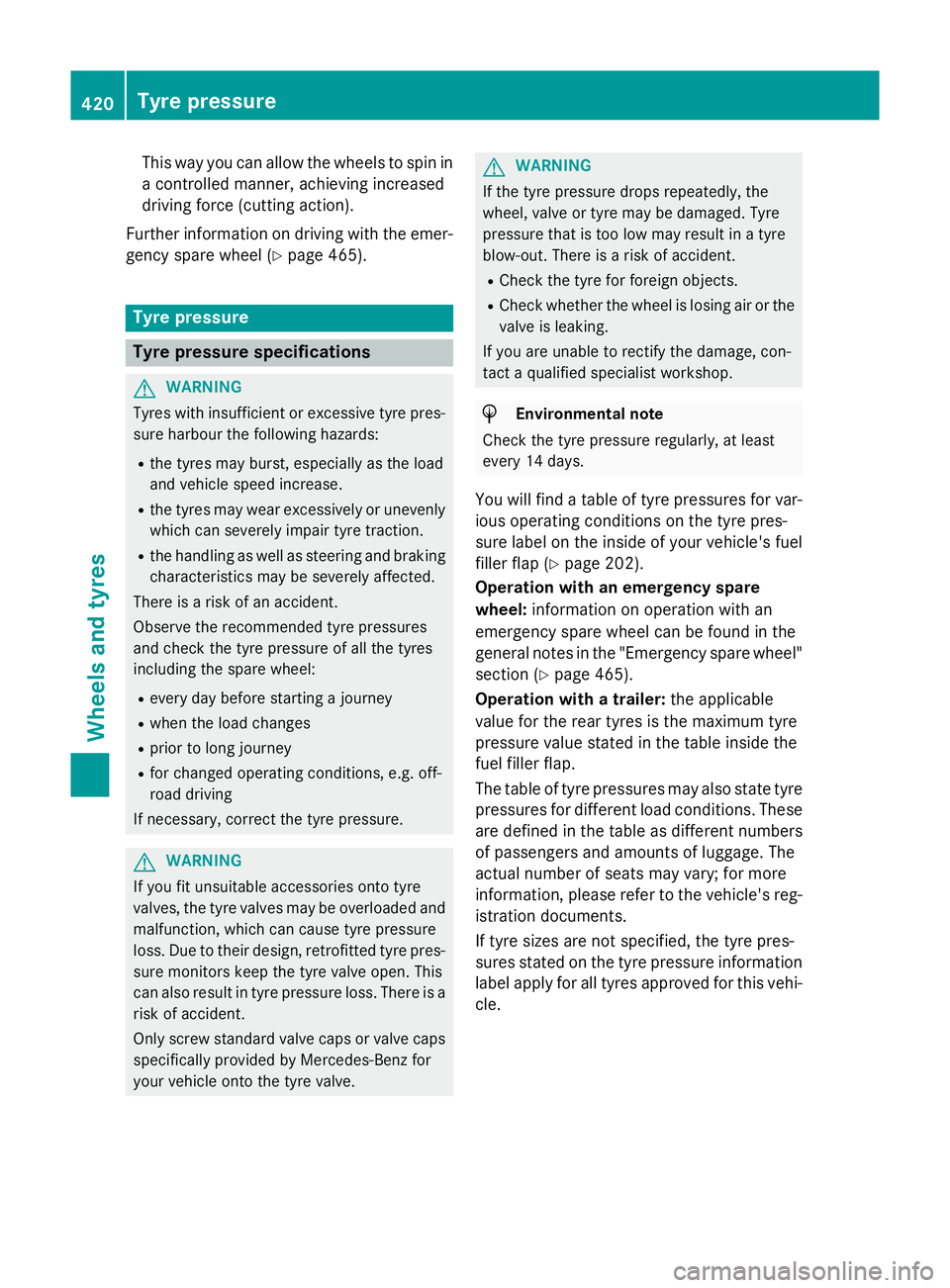
This way you can allow the wheels to spin in
ac ontrolled manner ,achieving increased
driving force (cutting action).
Further information on driving with the emer-
gency spare wheel (Y page 465).Tyrep
ressure Tyrep
ressure specifications G
WARNING
Tyres with insufficien torexcessiv etyre pres-
sure harbour the following hazards:
R the tyres may burst, especially as the load
and vehicle speed increase.
R the tyres may wear excessively or unevenly
which can severely impair tyre traction.
R the handling as well as steerin gand braking
characteristics may be severely affected.
There is arisk of an accident.
Observe the recommended tyre pressures
and check the tyre pressure of all the tyres
including the spare wheel:
R every day before starting ajourney
R when the load changes
R prior to long journey
R for changed operating conditions, e.g. off-
road driving
If necessary, correc tthe tyre pressure. G
WARNING
If you fit unsuitable accessories ontot yre
valves, the tyre valves may be overloaded and malfunction, which can cause tyre pressure
loss. Due to their design, retrofitted tyre pres-
sure monitors keep the tyre valve open. This
can also result in tyre pressure loss. There is a risk of accident.
Only screw standard valve caps or valve caps
specifically provided by Mercedes-Benz for
your vehicle ontot he tyre valve. G
WARNING
If the tyre pressure drops repeatedly, the
wheel, valve or tyre may be damaged. Tyre
pressure that is too low may result in atyre
blow-out. There is arisk of accident.
R Check the tyre for foreign objects.
R Check whether the wheel is losing air or the
valve is leaking.
If you are unable to rectify the damage, con-
tact aqualified specialist workshop. H
Environmenta
lnote
Check the tyre pressure regularly, at least
every 14 days.
You will find atable of tyre pressures for var-
ious operating conditions on the tyre pres-
sure label on the inside of your vehicle's fuel
filler flap (Y page 202).
Operation with an emergency spare
wheel: information on operation with an
emergenc yspare wheel can be found in the
general notes in the "Emergency spare wheel" section (Y page 465).
Operation with atrailer: the applicable
value for the rear tyres is the maximum tyre
pressure value stated in the table inside the
fuel filler flap.
The table of tyre pressures may also state tyre
pressures for different load conditions. These are defined in the table as different numbers
of passengers and amounts of luggage. The
actual number of seats may vary; for more
information, please refer to the vehicle's reg- istration documents.
If tyre sizes are not specified, the tyre pres-
sures stated on the tyre pressure information
label apply for all tyres approved for this vehi- cle. 420
Tyrep
ressureWheels and tyres
Page 476 of 497
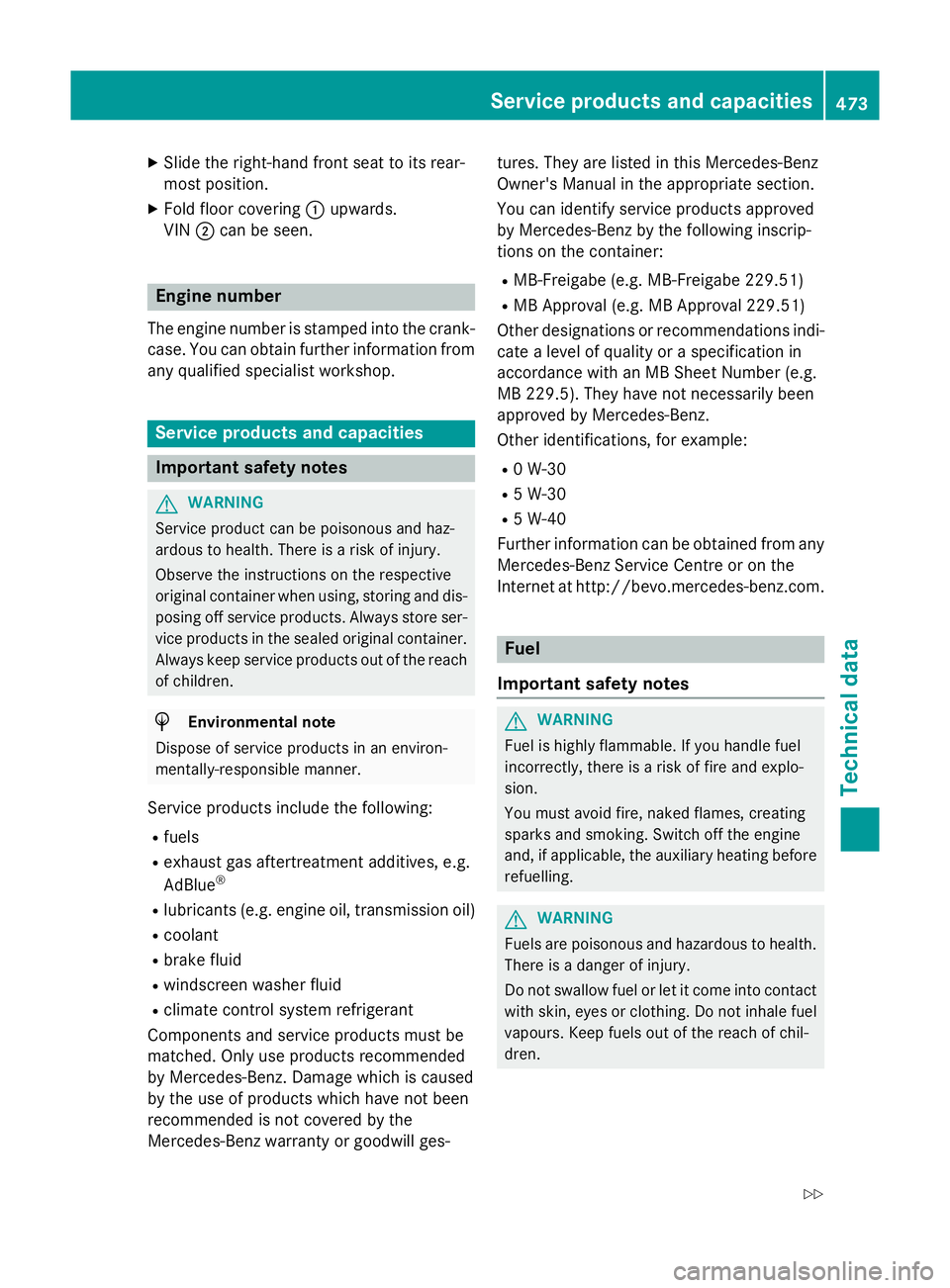
X
Slide the right-hand front sea ttoits rear-
mos tposition.
X Fol dfloor covering :upwards.
VIN ;can be seen. Engine number
The engine number is stampe dinto the crank-
case. Yo ucan obtain further information from
any qualified specialist workshop. Servic
eproducts and capacities Important safety notes
G
WARNING
Service product can be poisonous and haz-
ardou stohealth. There is ariskofi njury.
Observe the instructions on the respective
original containe rwhenu sing ,storing and dis-
posing off service products. Alway sstore ser-
vice products in the seale doriginal container.
Alway skeep service products ou tofthe reach
of children. H
Environmental note
Dispose of service products in an environ-
mentally-responsible manner.
Service products includ ethe following:
R fuels
R exhaus tgas aftertreatment additives, e.g.
AdBlue ®
R lubricants (e.g. engine oil, transmissio noil)
R coolant
R brake fluid
R windscreen washe rfluid
R climate control system refrigerant
Components and service products mus tbe
matched .Only us eproducts recommended
by Mercedes-Benz. Damage which is caused
by the us eofproducts which have not been
recommended is not covered by the
Mercedes-Benz warranty or goodwil lges- tures. The
yare listed in this Mercedes-Benz
Owner's Manua linthe appropriate section.
Yo uc an identif yservice products approved
by Mercedes-Benz by the following inscrip-
tions on the container:
R MB-Freigab e(e.g. MB-Freigab e229.51)
R MB Approva l(e.g. MB Approva l229.51)
Othe rdesignations or recommendations indi-
cate alevel of quality or aspecification in
accordance with an MB Shee tNum ber(e.g.
MB 229.5) .The yh aven ot necessaril ybeen
approved by Mercedes-Benz.
Othe ride ntifications ,for example:
R 0W -30
R 5W -30
R 5W -40
Further information can be obtaine dfrom any
Mercedes-Benz Service Centre or on the
Interne tath ttp://bevo.mercedes-benz.com. Fuel
Important safety notes G
WARNING
Fue lish ighl yf lammable. If yo uhandlef uel
incorrectly, ther eisariskoff irea nd explo-
sion.
Yo um usta void fire, nake dflames ,creating
sparks and smoking. Switch off the engine
and ,ifa pplicable, the auxiliary heating before
refuelling. G
WARNING
Fuels are poisonous and hazardou stohealth.
There is adanger of injury.
Do not swallo wfuelorl etit come into contact
with skin, eyes or clothing .Donot inhale fuel
vapours. Kee pfuels ou tofthe reach of chil-
dren. Servic
eproducts and capacities
473Technical data
Z
Page 477 of 497
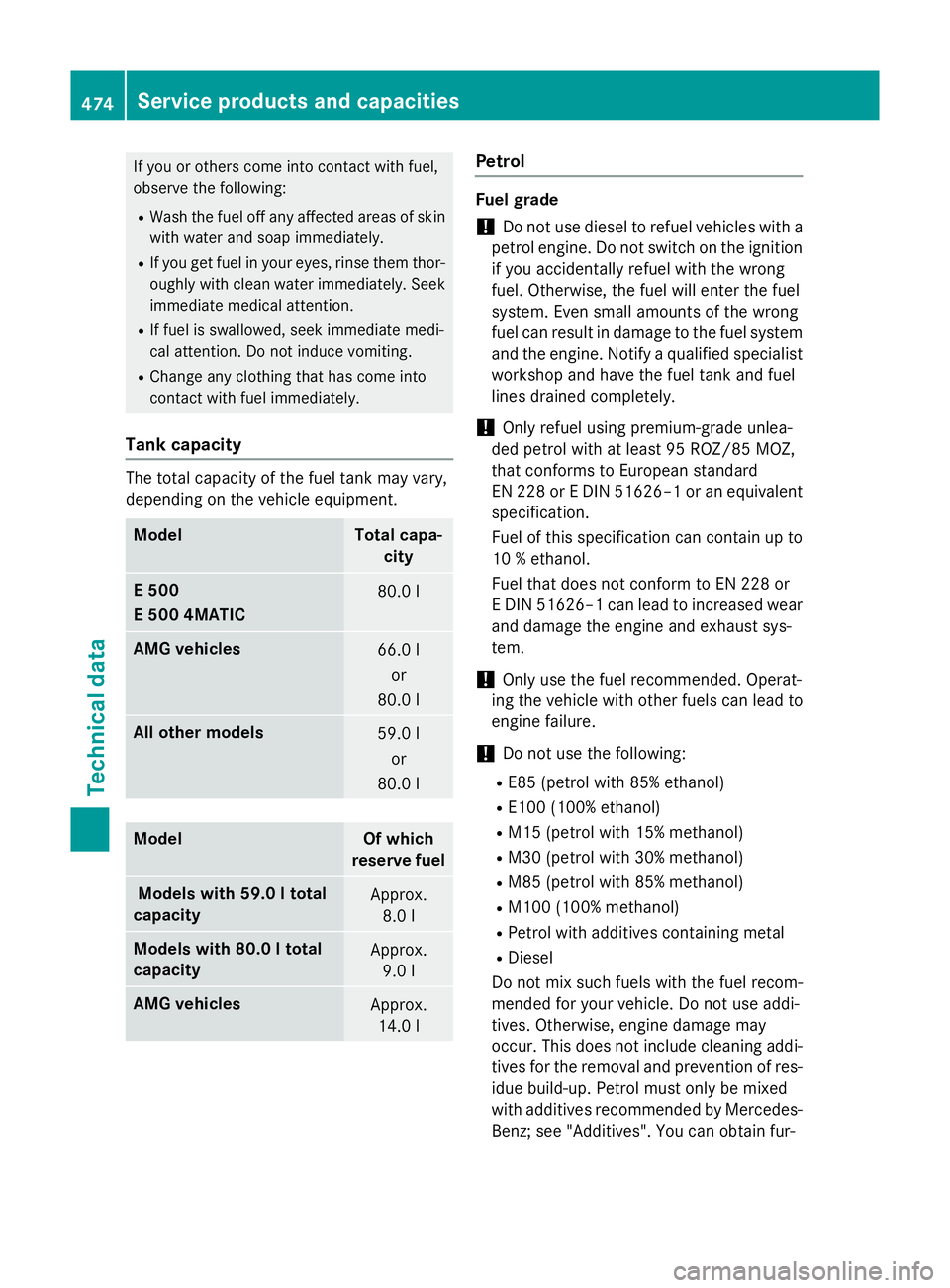
If you or others come into contact with fuel,
observe the following:
R Wash the fuel off any affected areasofs kin
with water and soap immediately.
R If you get fuel in youre yes,rinse them thor-
oughlyw ith clean water immediately.S eek
immediate medica lattention.
R If fuel is swallowed, seek immediate medi-
cal attention. Do not induce vomiting.
R Change any clothing that has come into
contact with fuel immediately.
Tank capacity The total capacity of the fuel tank may vary,
depending on the vehicle equipment.
Model Total capa-
city E5
00
E5 00 4MATIC 80.0 l
AMG vehicles
66.0 l
or
80.0 l All other models
59.0 l
or
80.0 l Model Of which
reserve fuel Models with 59.0
ltotal
capacity Approx.
8.0 l Models with 80.0
ltotal
capacity Approx.
9.0 l AMG vehicles
Approx.
14.0 l Petrol
Fuel grade
!
Do not use dieseltor
efuel vehicleswith a
petrol engine. Do not switch on the ignition if you accidentally refuel with the wrong
fuel.O therwise ,the fuel wille nter the fuel
system. Even small amounts of the wrong
fuel can resultind amage to the fuel system
and the engine. Notify aqualified specialist
workshop and have the fuel tank and fuel
lines drained completely.
! Only refuel using premium-grade unlea-
ded petrol with at least 95 ROZ/85 MOZ,
that conforms to Europea nstandard
EN 228 or EDIN 51626–1 or an equivalent
specification.
Fuel of this specification can contain up to
10 %ethanol.
Fuel that does not conform to EN 228 or
ED IN 51626–1 can leadtoi ncreased wear
and damage the engine and exhaust sys-
tem.
! Only use the fuel recommended. Operat-
ing the vehicle with other fuelsc an leadto
engine failure.
! Do not use the following:
R E85 (petrol with 85% ethanol)
R E100 (100% ethanol)
R M15 (petrol with 15% methanol)
R M30 (petrol with 30% methanol)
R M85 (petrol with 85% methanol)
R M100 (100% methanol)
R Petrol with additive scontaining metal
R Diesel
Do not mix such fuel switht he fuel recom-
mended for you rvehicle. Do not use addi-
tives. Otherwise ,engine damage may
occur. Thi sdoes not include cleaning addi-
tives for the remova land prevention of res-
idu eb uild-up. Petrol must only be mixed
with additive srecommended by Mercedes-
Benz; see "Additives". You can obtai nfur- 474
Service products and capacitiesTechnical data
Page 478 of 497
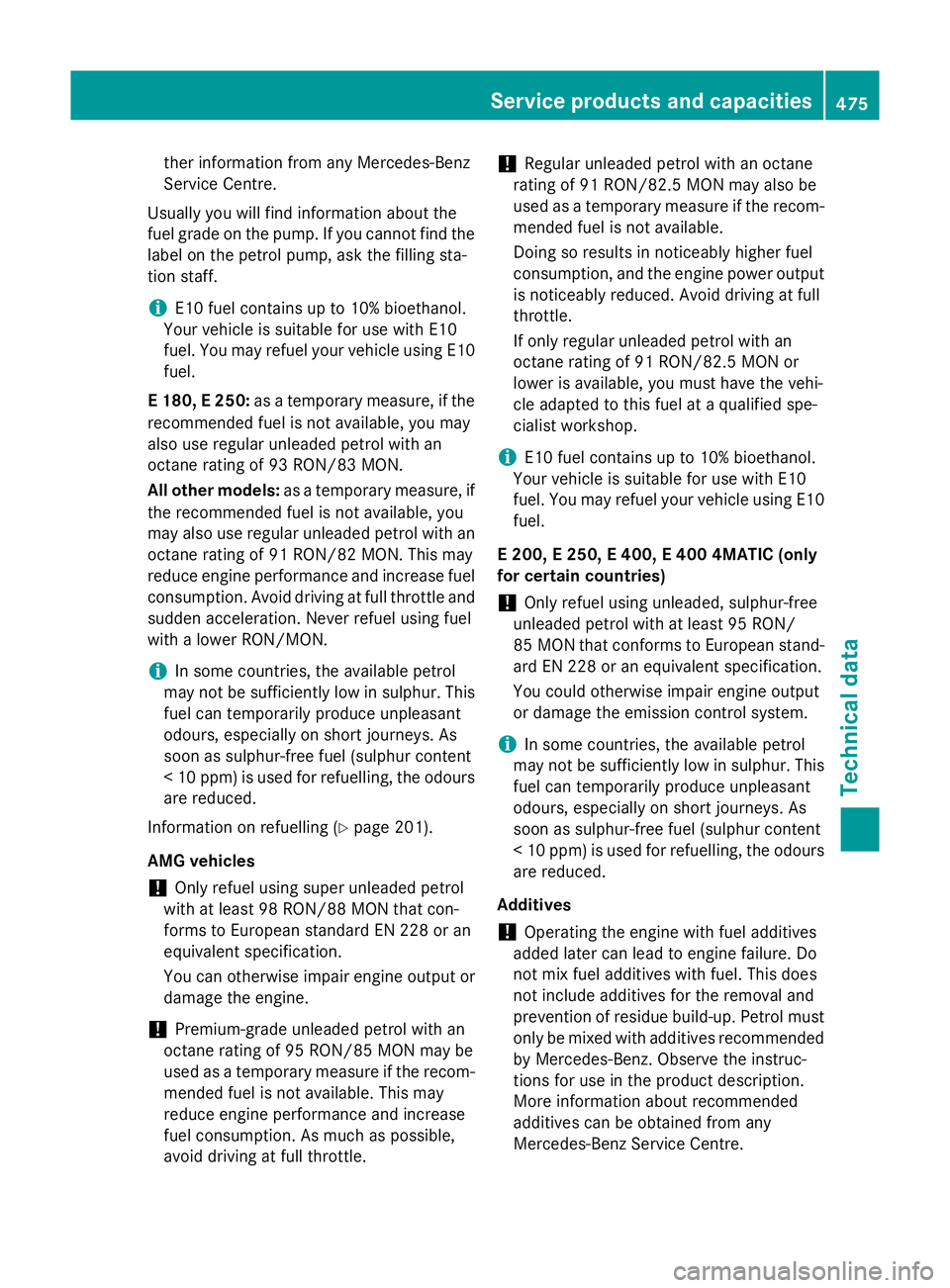
the
rinformation fro many Mercedes-Benz
Service Centre.
Usually yo uwillf indi nformation abou tthe
fuel grade on the pump. If yo ucannot find the
labe lont he petrol pump, as kthe filling sta-
tio ns taff.
i E10 fuel contains up to 10% bioethanol.
Your vehicl eissuitabl efor us ewithE 10
fuel .You ma yrefue lyou rvehicl eusing E10
fuel.
E1 80,E2 50:asatemporary measure, if the
recommended fuel is not available, yo umay
also us eregular unleade dpetrol with an
octane rating of 93 RON/83 MON.
Al lo ther models: asatemporary measure, if
the recommended fuel is not available, you
ma yalsou seregular unleade dpetrol with an
octane rating of 91 RON/82 MON .Thism ay
reduc eengine performance and increase fuel
consumption. Avoi ddriving at full throttle and
sudden acceleration. Never refue lusing fuel
with alower RON/MON.
i In some countries
,the availabl epetrol
ma ynot be sufficiently lo winsulphur .This
fuel can temporarily produce unpleasant
odours, especiall yonshort journeys. As
soon as sulphur-fre efuel(sulphu rcontent
<10p pm)isu sedf or refuelling, the odours
are reduced.
Information on refuelling (Y page201).
AMG vehicles ! Only refuel using super unleade
dpetrol
with at least 98 RON/88 MON that con-
forms to European standard EN 228 or an
equivalent specification.
You can otherwise impair engine output or
damage the engine.
! Premium-grade unleade
dpetrol with an
octane rating of 95 RON/85 MON may be
use dasat emporary measure if the recom-
mended fuel is not available .Thism ay
reduce engine performance and increase
fuel consumption. As much as possible,
avoi ddriving at ful lthrottle. !
Regular unleade
dpetrol with an octane
rating of 91 RON/82.5 MON may also be
use dasat emporary measure if the recom-
mended fuel is not available.
Doing so results in noticeably higher fuel
consumption, and the engine power output is noticeably reduced. Avoid driving at full
throttle.
If only regularu nleadedpetrol with an
octane rating of 91 RON/82.5 MON or
lower is available ,you must have the vehi-
cle adapted to this fuel at aqualified spe-
cialist workshop.
i E10 fuel contains up to 10% bioethanol.
You rvehicle is suitabl efor use with E10
fuel .You may refuel you rvehicle using E10
fuel.
E2 00,E2 50,E4 00,E4 00 4MATIC (only
for certain countries)
! Only refuel using unleaded, sulphur-free
unleade dpetrol with at least 95 RON/
85 MON that conforms to European stand-
ard EN 228 or an equivalent specification.
You coul dotherwise impair engine output
or damage the emission control system.
i In some countries, the available petrol
may not be sufficiently low in sulphur. This
fuel can temporaril yproduce unpleasant
odours, especially on short journeys. As
soon as sulphur-free fuel (sulphur content
<10p pm)isu sedf or refuelling, the odours
are reduced.
Additives ! Operating the engine with fuel additives
added later can lea dtoengine failure. Do
not mix fuel additive swithf uel .Thisd oes
not include additive sfor the remova land
prevention of residue build-up. Petrol must
only be mixed with additive srecommended
by Mercedes-Benz. Observe the instruc-
tions for use in the product description.
More information about recommended
additive scan be obtained from any
Mercedes-Benz Service Centre. Service products and capacities
475Technical data Z
Page 479 of 497
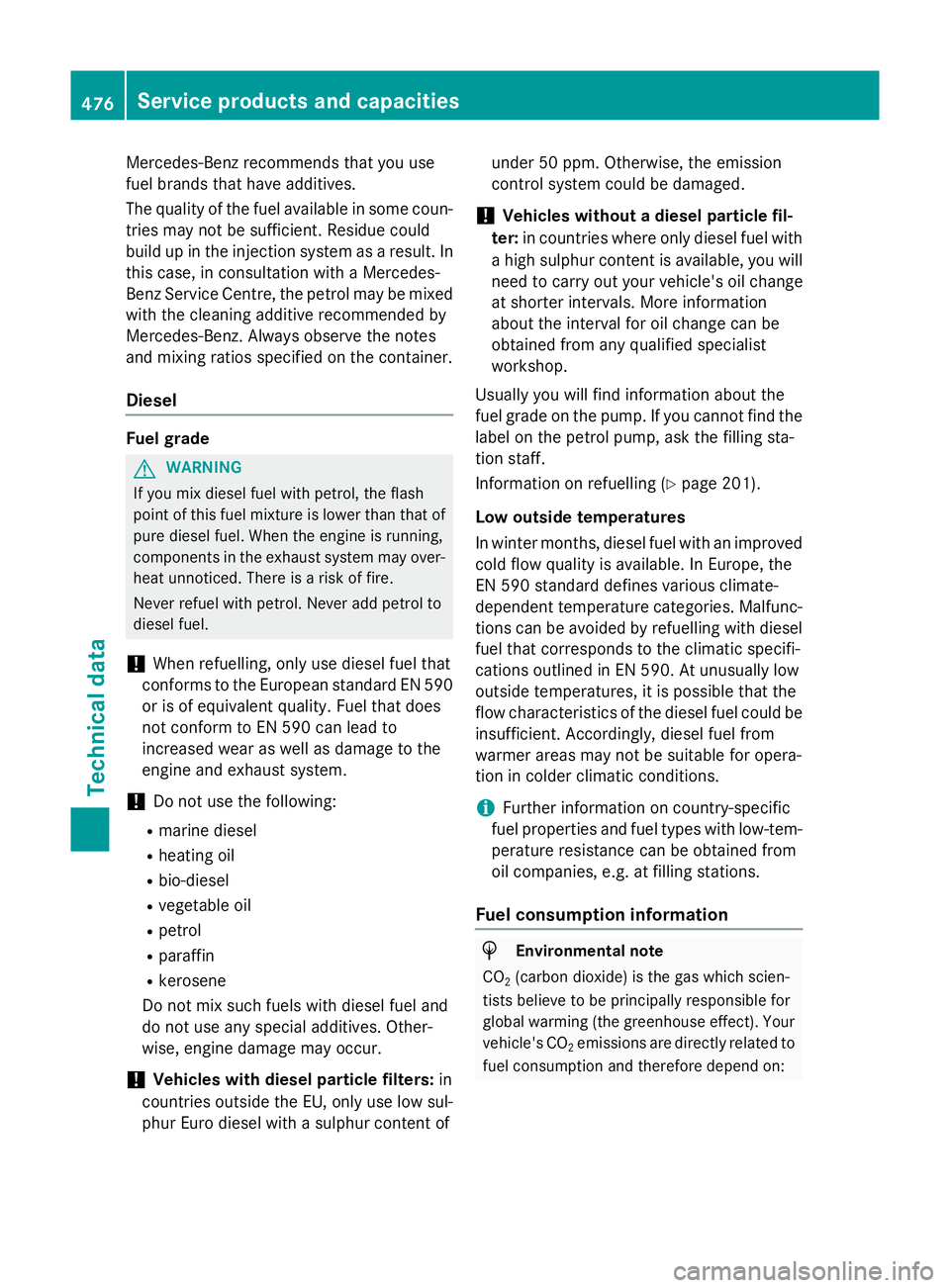
Mercedes-Ben
zrecommends that you use
fuel brands that have additives.
The quality of the fuel available in some coun- tries may not be sufficient. Residuec ould
build up in the injection system as aresult. In
this case, in consultation with aMercedes-
Benz Service Centre, the petrol may be mixed with the cleaning additive recommended by
Mercedes-Benz. Always observe the notes
and mixing ratios specified on the container.
Diesel Fuel grade
G
WARNING
If you mix diesel fuel with petrol, the flash
point of this fuel mixture is lower than that of pure diesel fuel. When the engine is running,
components in the exhaust system may over-
heat unnoticed. There is arisk of fire.
Never refuel with petrol. Never add petrol to
diesel fuel.
! When refuelling, only use diesel fuel that
conforms to the European standard EN 590
or is of equivalent quality. Fuel that does
not conformtoEN5 90 can lead to
increased wear as well as damage to the
engine and exhaust system.
! Do not use the following:
R marine diesel
R heating oil
R bio-diesel
R vegetable oil
R petrol
R paraffin
R kerosene
Do not mix such fuels with diesel fuel and
do not use any special additives. Other-
wise, engine damage may occur.
! Vehicles with diesel particle filters:
in
countries outside the EU, only use low sul-
phur Euro diesel with asulphurc ontent of under 50 ppm
.Otherwise, the emission
control system could be damaged.
! Vehicles without
adiesel particle fil-
ter: in countries where only diesel fuel with
ah igh sulphurc ontent is available, you will
need to carry out your vehicle's oil change
at shorter intervals. More information
about the interval for oil change can be
obtained from any qualified specialist
workshop.
Usuallyy ou will find information about the
fuel grade on the pump. If you cannot find the
label on the petrol pump, ask the filling sta-
tion staff.
Information on refuelling (Y page 201).
Low outside temperatures
In winter months, diesel fuel with an improved
cold flow quality is available. In Europe, the
EN 590 standard defines various climate-
dependent temperature categories. Malfunc- tions can be avoided by refuelling with diesel
fuel that corresponds to the climatic specifi-
cations outlined in EN 590. At unusually low
outside temperatures, it is possible that the
flow characteristics of the diesel fuel could be insufficient .Accordingly, diesel fuel from
warmer areas may not be suitable for opera-
tion in colder climatic conditions.
i Further information on country-specific
fuel properties and fuel types with low-tem-
perature resistance can be obtained from
oil companies, e.g. at filling stations.
Fuel consumption information H
Environmental note
CO 2(carbon dioxide) is the gas which scien-
tists believe to be principally responsible for
global warming (the greenhouse effect). Your vehicle's CO 2emissions are directly related to
fuel consumption and therefore depend on: 476
Service products and capacitiesTechnical data
Page 480 of 497
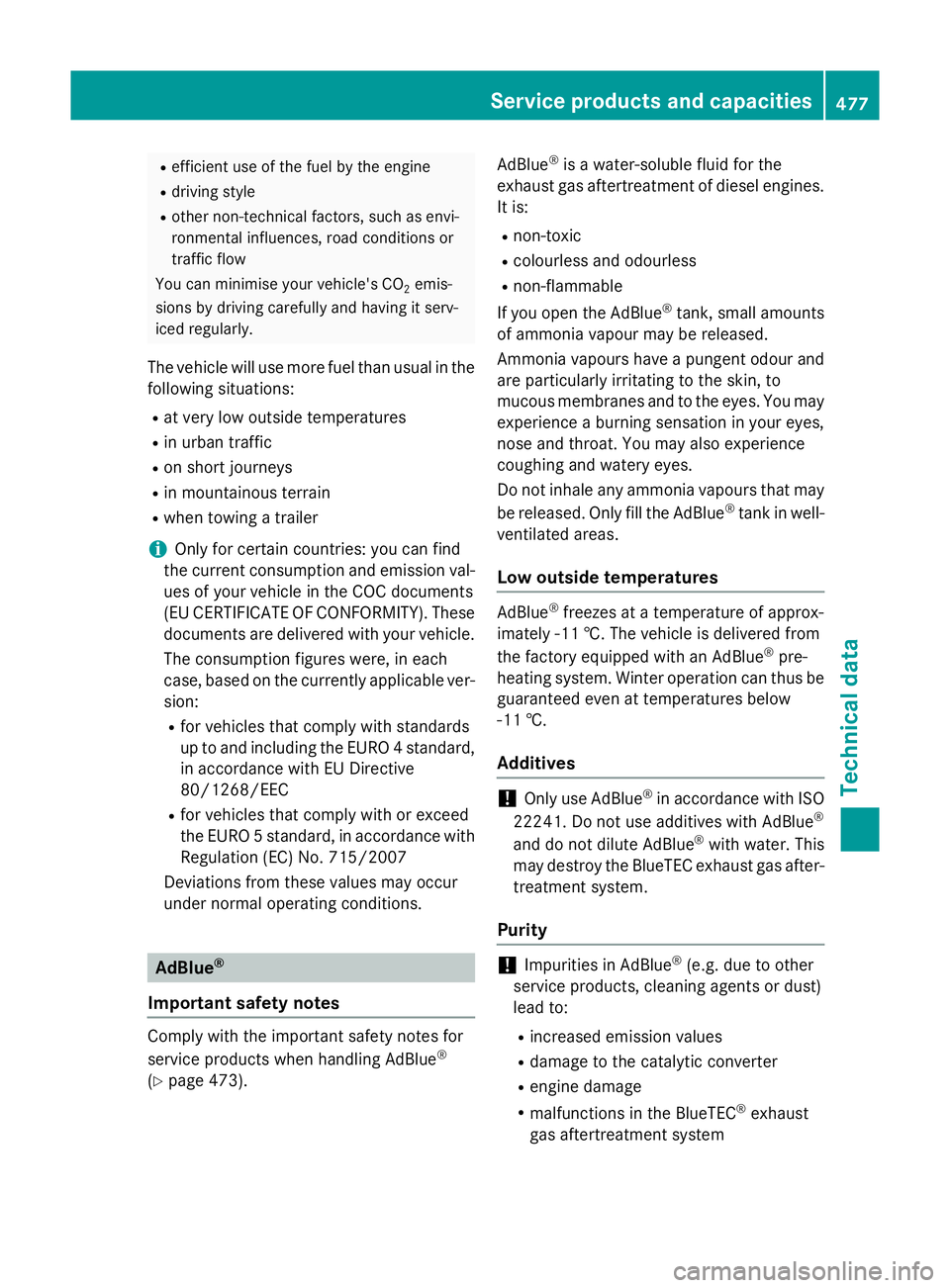
R
efficien tuse of the fuel by the engine
R driving style
R other non-technical factors, such as envi-
ronmental influences, road conditions or
traffic flow
You can minimise your vehicle's CO 2emis-
sions by driving carefully and having it serv-
iced regularly.
The vehicle will use more fuel than usual in the following situations:
R at very low outside temperatures
R in urban traffic
R on short journeys
R in mountainous terrain
R when towing atrailer
i Only for certain countries: you can find
the curren tconsumption and emission val-
ues of your vehicle in the COC documents
(EU CERTIFICATE OF CONFORMITY). These documents are delivered with your vehicle.
The consumption figures were, in each
case, based on the currently applicable ver- sion:
R for vehicles that comply with standards
up to and including the EURO 4standard,
in accordance with EU Directive
80/1268/EEC
R for vehicles that comply with or exceed
the EURO 5standard, in accordance with
Regulation (EC) No. 715/2007
Deviations from these values may occur
under normal operatin gconditions. AdBlue
®
Important safety notes Comply with the important safety notes for
servic
eproduct swhen handling AdBlue ®
(Y page 473). AdBlue
®
is aw ater-soluble fluid for the
exhaust gas aftertreatmen tofdiesel engines.
It is:
R non-toxic
R colourless and odourless
R non-flammable
If you open the AdBlue ®
tank ,small amounts
of ammonia vapour may be released.
Ammonia vapours have apungent odour and
are particularly irritating to the skin ,to
mucous membranes and to the eyes. You may experience aburning sensation in your eyes,
nose and throat. You may also experience
coughing and watery eyes.
Do not inhale any ammonia vapours that may
be released. Only fill the AdBlue ®
tank in well-
ventilated areas.
Low outsid etemperatures AdBlue
®
freezes at atemperature of approx-
imately -11 †. The vehicle is delivered from
the factory equipped with an AdBlue ®
pre-
heating system. Winter operation can thus be guaranteed even at temperatures below
-11 †.
Additives !
Only use AdBlue ®
in accordance with ISO
22241. Do not use additives with AdBlue ®
and do not dilute AdBlue ®
with water. This
may destro ythe BlueTEC exhaust gas after-
treatment system.
Purity !
Impurities in AdBlue ®
(e.g. due to other
servic eproducts, cleanin gagents or dust)
lead to:
R increased emission values
R damage to the catalytic converter
R engine damage
R malfunctions in the BlueTEC ®
exhaust
gas aftertreatmen tsystem Service products and capacities
477Technical data Z
Page 482 of 497
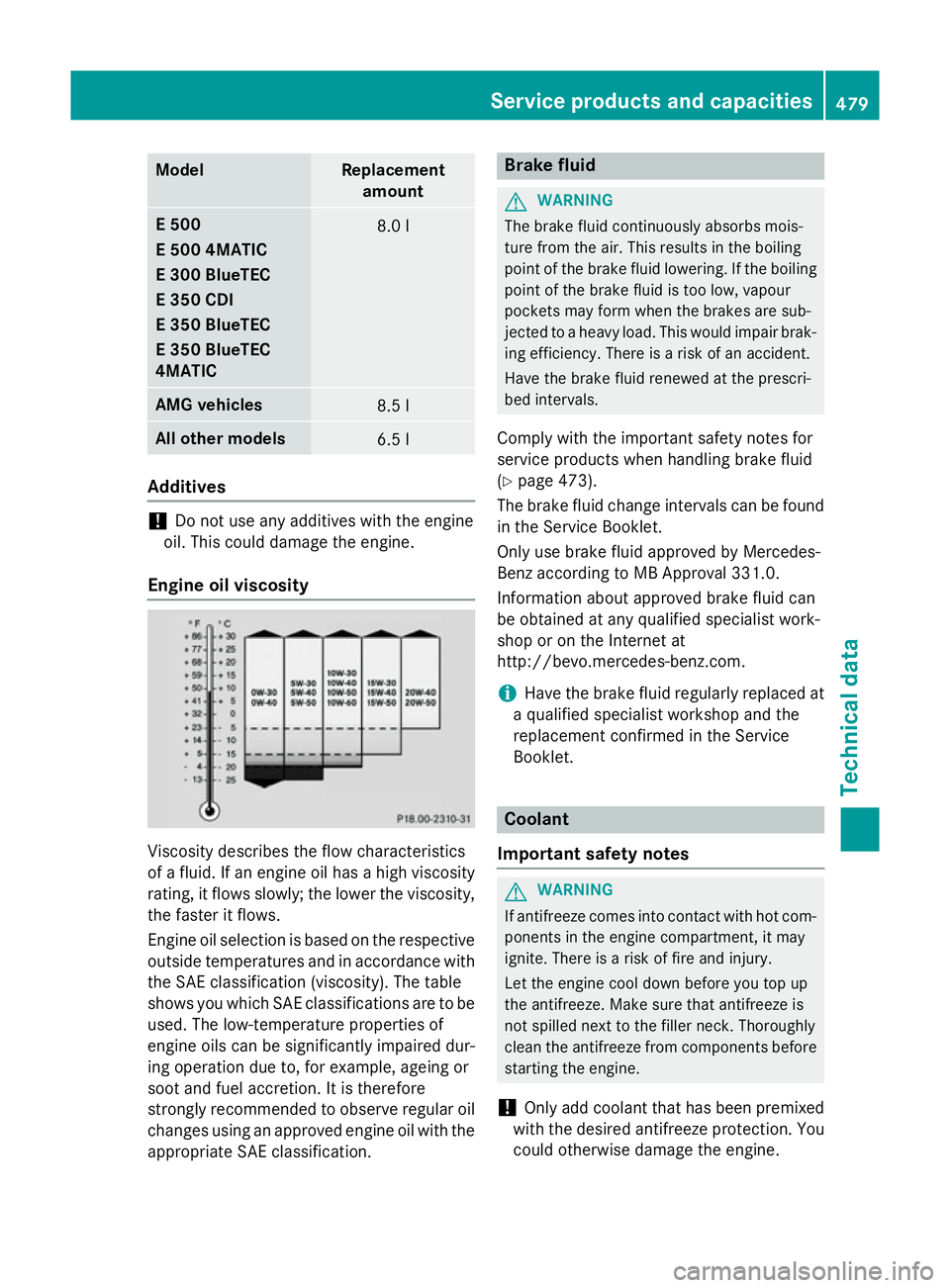
Model Replacement
amount E5
00
E5 00 4MATIC
E3 00 BlueTEC
E3 50 CDI
E3 50 BlueTEC
E3 50 BlueTEC
4MATIC 8.0 l
AMG vehicles
8.5 l
All other models
6.5 l
Additives
!
Do not use any additives with the engine
oil.T his coul ddamage the engine.
Engine oil viscosity Viscosity describes the flow characteristics
of afluid. If an engine oil has ahigh viscosity
rating, it flow sslowly;t he lower the viscosity,
the faster it flows.
Engine oil selection is based on the respective outside temperatures and in accordance with
the SAE classification (viscosity) .The table
show syou which SAE classifications are to be
used. The low-temperature properties of
engine oilsc an be significantly impaired dur-
ing operation due to, for example, ageing or
soot and fuel accretion. It is therefore
strongly recommende dtoobserve regular oil
changes using an approved engine oil with the
appropriate SAE classification. Brake fluid
G
WARNING
The brake flui dcontinuously absorbs mois-
ture from the air. This results in the boiling
point of the brake flui dlowering. If the boiling
point of the brake flui distoo low,v apour
pockets may form when the brakes are sub-
jected to aheavy load. This would impair brak-
ing efficiency. There is arisk of an accident.
Have the brake flui drenewe datthe prescri-
bed intervals.
Comply with the important safety notes for
service products when handling brake fluid
(Y page4 73).
The brake flui dchange interval scan be found
in the Service Booklet.
Only use brake flui dapproved by Mercedes-
Benz according to MB Approva l331.0.
Information about approved brake flui dcan
be obtained at any qualified specialist work-
shop or on the Internet at
http://bevo.mercedes-benz.com.
i Have the brake flui
dregularl yreplaced at
aq ualified specialist worksho pand the
replacement confirmed in the Service
Booklet. Coolant
Important safety notes G
WARNING
If antifreeze comes into contact with hot com- ponents in the engine compartment, it may
ignite. There is arisk of fire and injury.
Let the engine cool downb efore you top up
the antifreeze. Make sure that antifreeze is
not spilled next to the filler neck. Thoroughly
clea nthe antifreeze from components before
starting the engine.
! Only add coolant that has been premixed
with the desired antifreeze protection. You
coul dotherwise damage the engine. Servic
eproducts and capacities
479Technical data Z